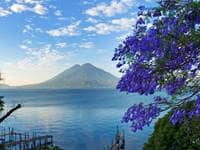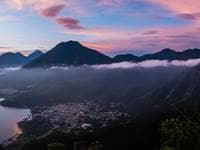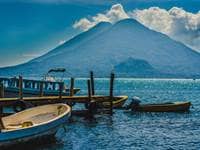
- Trending:
- Forgiveness
- |
- Resurrection
- |
- Joy
- |
- Afterlife
The 100 Most Holy Places On Earth
Lake Atitlán





Associated Faiths:
Maya Civilization
Also visited by tourists, religious and non-religious, from many different traditions
Accessibility:
Open to visitors.
Annual Visitors: 275,000
History
Lake Atitlán, the “deepest lake in Central America,” is located in the highlands of the portion of the Sierra Madre mountain range which runs through Guatemala. The name “Atitlán” comes from “ati” (the word for “water”) and “titan” (which means “between”). Thus, Atitlán means “between the waters.” While that name doesn’t make much sense, interpretively, it means that it is the place where “rainbows get their color.” (Of course, the rainbow’s color is caused by water droplets in the atmosphere breaking sunlight into its various colors through refraction.) So, Lake Atitlán is the place where the ancient Guatemalans felt that rainbows began, drawing upon the water of the lake, and the refraction of light “between” those droplets, causing rainbows.
Volcanic activity in the region, occurring approximately 1.8 million years ago, is believed to have resulted in the creation of the large cauldron-like hollow (or “caldera”) that is now Lake Atitlán. Much of that pre-historic caldera is currently filled with water as deep as 1,120 feet. Thus, this lake is almost 2 million years old. Though a very deep lake for the region, a massive 7.5 earthquake (in 1976) cracked the lake’s basin, causing the water level to drop approximately 6 ½ feet in only 30 days.
Often called “the most beautiful lake in the world,” its tall abutting cliffs (which frame the lake) have become a popular tourist attraction. Individuals come from all over the world to see the rock overhangs—particularly those into cliff diving. This is a site of religious tourism, but also fishing, boating, and other popular non-religious tourist activities. Indeed, unlike most locations in our list, Lake Atitlán feels much less “religious” (to non-residents) than do the various other cities and sites we have highlighted in our list.
Religious Significance
For religious naturalists, Lake Atitlán is a “sacred site” just by virtue of its beauty, its preservation for two million years, and for the natural setting in which it is found. For those who feel closest to God when in nature, and for those who feel that nature is their Church and their religion, this deep, beautiful, and natural ancient lake, is as important of a pilgrimage site as any in the Hindu, Christian, or Islamic worlds. God is eerily present in this natural cathedral.
Aside from religious naturalism, Lake Atitlán also has strong religious connections to the Mayan tradition. In traditional Mayan belief, water is equivalent to life. In their ceremonies or rites, water is always present and employed. Water is connected to Mayan rain deities and, thus, interacting with the lake was a means of interacting with and petitioning the divine. To this day, the villages which surround Lake Atitlán—and their culture—are heavily influenced by the Maya people and their beliefs. Thus, the lake is sacred to those who live around it, as it is a central part of their belief system.
Related to the Mayan influence in the area, the residents of Santiago Atitlán—the largest of the lakeside communities surrounding Lake Atitlán—worship Maximón (or San Simón), a deity created out of the syncretism of traditional Mayan deities with Roman Catholic Saints (such as Saint Peter) and somewhat surprising figures (including the conquistador, Pedro de Alvarado, Jesus’ betrayer, Judas Iscariot, and ancestral deities). Among other things, Maximón is said to protect the people around the lake—including the families of fishermen who worked the lake.
An additional reason for the sacral nature of Lake Atitlán has to do with a tragic event which affected the area in the 21st century. In October of 2005, torrential rains in the area caused a massive landslide which buried nearly the entire lakeside village of Panabaj. Some 1,400 residents were killed and 5,000 were left homeless. While some bodies were recovered from under the tons of earth that had consumed the village, the majority of the deceased were never recovered, causing the mayor of Santiago Atitlán to declare the village a “mass gravesite” or “cemetery.”
Whether one is a religious naturalist, a believer in the gods and faith-traditions of the Mayan peoples, or one who reveres life and the stands in awe of the tragic loss thereof, Lake Atitlán offers something for you. One cannot help but be in awe of the beauty, depth, and the life-sustaining power of the lake. But those familiar with its recent history will also feel a sense of reverence at knowing that they walk where nearly 1,500 humans lost their lives, evidencing the power of nature and—for Mayans—the power of the gods of water and weather.








